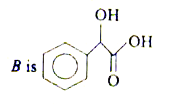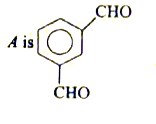A hydrocarbon A of the molecular formula C8H10. On ozonolysis gives only the compound B(C4H6O2). The compound B can also be obtained from the alkyl bromide C(C3H5Br) upon treatment with Mg in dry ether followed by the addition of CO2 and acidification. Identify A,B and C and also give equations for the reactions.
To solve the problem, we need to identify the compounds A, B, and C based on the given information. Let's break down the solution step by step.
Step 1: Determine the structure of compound A (C8H10)
The molecular formula of compound A is C8H10. To find the degree of unsaturation (DU), we can use the formula:
DU=2C+2−H2
Substituting the values for A:
DU=2(8)+2−102=16+2−102=82=4
A degree of unsaturation of 4 suggests that A could contain multiple double bonds or rings.
Step 2: Analyze the ozonolysis of A to form B (C4H6O2)
Compound B has the molecular formula C4H6O2. We can calculate its degree of unsaturation:
DU=2(4)+2−62=8+2−62=42=2
This indicates that B has two degrees of unsaturation, which could be due to one double bond and one ring or two double bonds.
Step 3: Identify compound C (C3H5Br)
The alkyl bromide C has the formula C3H5Br. We can calculate its degree of unsaturation:
DU=2(3)+2−52=6+2−52=32=1.5
This suggests that C has one degree of unsaturation, indicating it likely has a double bond or a ring.
Step 4: Determine the reaction sequence involving C
The reaction of C with magnesium in dry ether forms a Grignard reagent:
CMg, dry ether−−−−−−−−→C3H5MgBr
Next, the Grignard reagent reacts with carbon dioxide:
C3H5MgBr+CO2→C3H5COOMgBr
Upon acidification, this gives the carboxylic acid:
C3H5COOMgBr+H+→C3H5COOH+MgBrOH
This compound is B (C4H6O2), which can be represented as butanoic acid (or 3-methylbutanoic acid).
Step 5: Identify compound A
Given that ozonolysis of A gives B, A is likely a compound that can yield two molecules of B upon cleavage. A possible structure for A could be 1,3-diphenylpropene, which has the formula C8H10 and can yield two molecules of B upon ozonolysis.
Final Identification:
- A: 1,3-diphenylpropene (C8H10)
- B: Butanoic acid (C4H6O2)
- C: 3-bromopropene (C3H5Br)
Reaction Equations:
1. Ozonolysis of A:
C8H10O3−→2C4H6O2
2. Formation of B from C:
C3H5BrMg, dry ether−−−−−−−−→C3H5MgBr
C3H5MgBr+CO2→C3H5COOMgBr
C3H5COOMgBr+H+→C3H5COOH+MgBrOH
The molecular formula of compound A is C8H10. To find the degree of unsaturation (DU), we can use the formula:
Compound B has the molecular formula C4H6O2. We can calculate its degree of unsaturation:
The alkyl bromide C has the formula C3H5Br. We can calculate its degree of unsaturation:
The reaction of C with magnesium in dry ether forms a Grignard reagent:
Given that ozonolysis of A gives B, A is likely a compound that can yield two molecules of B upon cleavage. A possible structure for A could be 1,3-diphenylpropene, which has the formula C8H10 and can yield two molecules of B upon ozonolysis.
- A: 1,3-diphenylpropene (C8H10)
- B: Butanoic acid (C4H6O2)
- C: 3-bromopropene (C3H5Br)
1. Ozonolysis of A:
C8H10O3−→2C4H6O2
C3H5BrMg, dry ether−−−−−−−−→C3H5MgBr
C3H5MgBr+CO2→C3H5COOMgBr
C3H5COOMgBr+H+→C3H5COOH+MgBrOH
Topper's Solved these Questions
- GRIGNARD REAGENTS AND ORGANOMETALLIC REAGENTSBOOK - CENGAGE CHEMISTRY ENGLISHCHAPTER - GRIGNARD REAGENTS AND ORGANOMETALLIC REAGENTSEXERCISE - Exercises Archives (Linked Comprehension)
1 Videos
- GRIGNARD REAGENTS AND ORGANOMETALLIC REAGENTSBOOK - CENGAGE CHEMISTRY ENGLISHCHAPTER - GRIGNARD REAGENTS AND ORGANOMETALLIC REAGENTSEXERCISE - Exercises Archives (True/False)
1 Videos
- GENERAL PRINCIPLES AND PROCESS OF ISOLATION OF ELEMENTSBOOK - CENGAGE CHEMISTRY ENGLISHCHAPTER - GENERAL PRINCIPLES AND PROCESS OF ISOLATION OF ELEMENTSEXERCISE - Archives (Subjective)
14 Videos
- NCERT BASED EXERCISEBOOK - CENGAGE CHEMISTRY ENGLISHCHAPTER - NCERT BASED EXERCISEEXERCISE - Nuclear Chemistry (NCERT Exercise)
29 Videos
Similar Questions
Knowledge Check
Compound (A) C8H6O2 on treatment with aq. NaOH followed by acidification gives (B) C3H2O3 which on oxidation gives benzoic acid only:
A B
B C
C D
D
An organic compound C4H6 on ozonolysis give HCHO,CO2,CH3CHO. Compound will be:
AH2C=CH−CH=CH2BCH3−CH=C=CH2CCH3−C=C−CH3D
An alkene 'A' (molecular formula C5H10) on ozonolysis gives a mixture of two compounds 'B' and 'C'. Compound 'B' gives positive Fehling's test and also forms iodoform on treatement with I2 and NaOH. Compound 'C' does not give Fehling's test but forms iodoform. Identify the compounds A, B and C. Write the reaction for ozonolysis and formation of iodoform from B and C.
View SolutionAn alkene 'A' (molecular formula C5H10) on ozonolysis gives a mixture of two compounds 'B' and 'C'. Compound 'B' gives positive Fehling's test and also forms iodoform on treatement with I2 and NaOH. Compound 'C' does not give Fehling's test but forms iodoform. Identify the compounds A, B and C. Write the reaction for ozonolysis and formation of iodoform from B and C.
View SolutionAn alkene 'A' (molecular formula C5H10) on ozonolysis gives a mixture of two compounds 'B' and 'C'. Compound 'B' gives positive Fehling's test and also forms iodoform on treatement with I2 and NaOH. Compound 'C' does not give Fehling's test but forms iodoform. Identify the compounds A, B and C. Write the reaction for ozonolysis and formation of iodoform from B and C.
View SolutionAn alkene 'A' (molecular formula C5H10) on ozonolysis gives a mixture of two compounds 'B' and 'C'. Compound 'B' gives positive Fehling's test and also forms iodoform on treatement with I2 and NaOH. Compound 'C' does not give Fehling's test but forms iodoform. Identify the compounds A, B and C. Write the reaction for ozonolysis and formation of iodoform from B and C.
View SolutionReduction of hexose A (molecular formula C6H12O6) with sodium borohydride gives compound B and C. Compound B is optically inactive, whereas compound C is optically active. Which of the following is compound A?
View SolutionA compound A having molecular formula (C3H9N) on treatment with benzenesulfonyl chloride gives an insoluble solid. Identify A
View Solution
